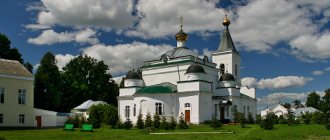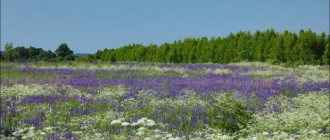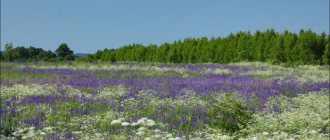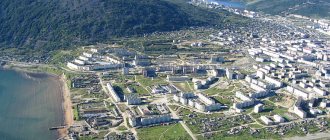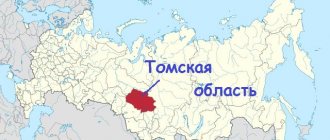The Smolensk region is one of the territorial subjects of the Russian Federation. It is located in the west of the Central Federal District, in Central Russia. The administrative center is the city of Smolensk. The city is closer to Minsk than to Moscow: the distance to the first is 331 km, and to the second – 365 km.
In the west the region has a border with Belarus. On the other three sides - with the regions of Russia. The area of the Smolensk region is 49,779 square meters. km, population – 949,348 people. Population density – 19.07 people/sq. km. The date of formation is September 27, 1937. The time corresponds to Moscow.
The Smolensk district of the Smolensk region is located in its western part. Its administrative center is the city of Smolensk.
Geography and economics
The region is located on the Russian Plain. The terrain is undulating and hilly. Among the minerals most often found are building materials, brown coal, and peat.
The climate is moderate continental. In January the average temperature reaches minus 7 degrees, and in July +18 degrees. The amount of precipitation per year is 630-730 mm.
Industry in the region is moderately developed. The most important are: electric power, mechanical engineering, chemical, jewelry and food industries.
Brief description of the Smolensk region
The region, in the modern sense, was formed on September 27, 1937. Today its area is 49,786 square meters. km. The length of the region from west to east along the parallel of the city of Gagarin is 280 km, from north to south along the meridian of the city of Roslavl - 250 km. Almost the entire region is located on the Smolensk-Moscow Upland, in the west of the East European Plain. In the center and east, hills predominate, dissected by deeply incised river valleys. The average surface height is about 220 meters above sea level.
The hills are crossed by many rivers and small streams (the total number of the latter is 1149). 60 percent of the territory is washed by the rivers of the Dnieper system (the Dnieper takes its sources here - in the Sychevsky region, its main tributaries are the Sozh, Desna), 25 percent - by the Volga basin (Ugra, Vazuza), 15 percent - by the Western Dvina basin. About 50 Smolensk lakes are of glacial origin.
Once upon a time, the entire territory of the Smolensk region was covered with forests; now they occupy about one fifth of the area. The alternation of forests and open spaces on the hills and river valleys creates landscapes of unique charm.
The climate is temperate continental. Summer is warm (average temperature in July is 17-18 degrees Celsius), winter is moderately cold (average temperature in January is minus 8.5). Annual precipitation ranges from 530 to 650 mm.
In the depths of the Smolensk region lies a number of minerals. Among them: low-calorie brown coals (reserves up to 1.5 billion tons), peat (reserves about 450 million tons), a number of deposits of building materials (clays, loams, dolomites, chalk, marl, limestones, etc.). Reserves of sulfate-calcium-magnesium mineral waters have been discovered and are widely used. In the lakes of the region there are significant reserves of sapropels (more than 150 million cubic meters). The region is located in a zone of mixed forests. The total area of forest land is 2093.9 thousand hectares, including 1000.2 thousand hectares under the jurisdiction of state forestry authorities. The average age of the plantings is 44 years.
Great importance is attached to the development of natural (national) parks, which were created to protect landscapes and unique natural complexes. On the territory of the region, the Smolensk Poozerie National Park has been formed with an area of 146.2 thousand hectares, of which 112.5 thousand hectares are forests.
The land fund of the Smolensk region is 4977.9 thousand hectares.
The fauna of the region is rich and diverse. Its territory is home to 55 species of mammals, about 260 species of birds, and 40 species of fish. Hares, squirrels, foxes, wild boars, moose, and wolves are widespread in the forests; bears, lynxes, martens, weasels, and stoats are also found.
Rivers and lakes are rich in pike, pike perch, bream, perch, burbot, and other species of fish. All this creates the prerequisites for the future organization of sport hunting, fishing, and short-term recreation.
| Order of November 1, 2010 N 1537-r/adm. About the creation of SOGBU< Previous | Next >Historical information |
Administrative division
The Smolensk region includes 24 districts, 23 urban settlements, 278 rural settlements and 2 urban districts (Smolensk and Desnogorsk). There are a total of 257 municipalities within the district of the same name. These include 207 rural settlements, 23 urban settlements, 25 municipal districts and 2 urban districts.
Smolensky district
This is one of the districts of the Smolensk region of Russia. Its center is the city of Smolensk. However, it is not part of the district itself. The climate in this region is humid and moderately cool. Summer is not hot, humid. Winter is moderate and snowy.
The Smolensk district is located in the west of the Smolensk region, but not on the very outskirts. In the north it borders with the Demidovsky district, in the southeast - with the Monastyrshchinsky and Pochinkovsky districts, in the east - with the Kardymovsky and Dukhovshchinsky districts, in the southwest - with the Rudnyansky and Krasninsky districts.
The area of the Smolensk region is 2895 square meters. km. Rivers such as the Dnieper, Nagat, Sozh, Olsha, and Stabna flow through it. Lake Kuprinskoye is located within this territorial entity.
The date of appearance of the district was 1929. The head of the administration of the Smolensk district of the Smolensk region is Olga Yuryevna Yazeva.
Smolensk region
Regional cooperation
Area of the Smolensk region:
49.8 thousand km².
Population of the Smolensk region:
921.1 thousand people (as of January 1, 2021)
The main areas of specialization of the Smolensk region:
mechanical engineering, transport and logistics, chemical production, production of rubber and plastic products, woodworking, flax growing and processing, greenhouse vegetable growing, dairy farming and milk processing, electric power, information technology.
The largest enterprises of the Smolensk region:
LLC "Factory "Sharm", LLC "Vyazemskaya Garment Factory", LLC "Pochinkovskaya Garment Factory", LLC Safonovskaya Garment Factory "Orel", LLC "STK PK", JSC "Smolensk Hosiery and Knitting Factory "NASHE", LLC "VKP LT" ", EGGER DREVPRODUCT GAGARIN LLC, Dorogobuzh PJSC, Avangard JSC, Lava LLC, SMIT-Yartsevo LLC, Desnogorsk Polymer LLC, Vyazma-Brusit LLC, TMK - YARTSEVSKY MET LLC, JSC Vyazemsky Machine-Building, FSUE SPO Analitpribor, JSC Ledvans, JSC Safonovsky, JSC Teplokontrol, JSC Smolensk Radio Components Plant, LLC, JSC SmAZ, JSC PO Kristall, Vyazemsky Reinforced Concrete Plant sleepers - a branch of BetElTrans JSC, Dorogobuzhkotlomash LLC, Ruselprom-SEZ LLC, NII STT JSC, Plastic Republic LLC.
Regulatory and legal framework for cooperation
of the Smolensk region with the regions of the Republic of Belarus
The Administration of the Smolensk region has concluded agreements on trade, economic, scientific, technical and cultural cooperation with the Mogilev regional executive committee, the Vitebsk regional executive committee, the Minsk regional executive committee, the Grodno regional executive committee, the Brest regional executive committee, the Government of the Republic of Belarus, Gomel Regional Executive Committee.
The Smolensk Regional Duma has concluded agreements with the Brest Regional Council of Deputies and the Mogilev Regional Council of Deputies.
Main macroeconomic indicators of the Smolensk region
Table 1. Macroeconomic indicators
| Indicators | 2019 | 2020 |
| Gross regional product, million rubles | 348 061,5 | * |
| GRP, % in comparable prices to the previous period | 100,0 | * |
| GRP per person, rubles | 370 820,2 | * |
| Industrial production, million rubles | 268 911,7 | 287 638,0 |
| Industrial production,% compared to last year | 105,1 | 105,0 |
* no statistical data available. The deadline for Rosstat to publish data for 2021 is the first half of 2022.
International trade
Table 2. Data on trade turnover of the Smolensk region
million US dollars (according to the Federal Customs Service)
| Turnover/tempo | Export | Import | ||||
| 2019 | 2020 | 2019 | 2020 | 2019 | 2020 | |
| with all countries | 3 088,7 97,8 | 2 985,0 96,6 | 1 133,4 | 1003,7 | 1955,3 | 1 981,3 |
| with the Republic of Belarus | 1 856,1 101,9 | 1 935,3 104,3 | 457,2 | 411,6 | 1 398,9 | 1 523,7 |
Table 3. Structure of supplies from the Smolensk region
to the Republic of Belarus based on the results of 2019-2020.
thousand US dollars (according to the Federal Customs Service)
| TN code foreign trade activities | Name of product | 2019 | 2020 | Rate, in % |
| All goods | 456 863,0 | 411 326,0 | 90,0 | |
| 01-24 | food products and agricultural raw materials | 77 520, | 70 503,0 | 90,9 |
| 25-27 | mineral products | 3 122,8 | 2 802,8 | 89,8 |
| 28-40 | chemical industry products, rubber | 93 549,9 | 80 713,3 | 86,3 |
| 41-43 | leather raw materials, furs and products made from them | 2 444,0 | 1 707,6 | 69,9 |
| 44-49 | wood and pulp and paper products | 40 958,1 | 39 162,9 | 95,6 |
| 50-67 | textiles, textile products, shoes | 32 453,4 | 32 330,2 | 99,6 |
| 71 | pearls, precious stones, metals | 134,7 | 110,3 | 81,9 |
| 72-83 | metals, products made from them | 67 321,9 | 59 887,9 | 89,0 |
| 84-90 | machines, equipment, vehicles | 107 766,5 | 95 243,6 | 88,4 |
| 68-70, 91-97 | other goods | 31 591,7 | 28 864,4 | 91,4 |
Table 4. Structure of supplies from the Republic of Belarus
to the Smolensk region based on the results of 2019-2020.
thousand US dollars (according to the Federal Customs Service)
| TN code foreign trade activities | Name of product | 2019 | 2020 | Rate, in % |
| All goods | 1 398 693,9 | 1 523 444,5 | 108,9 | |
| 01-24 | food products and agricultural raw materials | 561 001,1 | 560 126,5 | 99,8 |
| 25-27 | mineral products | 32 029,7 | 131 858,3 | 411,7 |
| 28-40 | chemical industry products, rubber | 196 732,1 | 197 188,8 | 100,2 |
| 41-43 | leather raw materials, furs and products made from them | 4 409,6 | 5 527,9 | 125,4 |
| 44-49 | wood and pulp and paper products | 36 125,1 | 42 107,1 | 116,6 |
| 50-67 | textiles, textile products, shoes | 90 011,8 | 79 653,4 | 88,5 |
| 71 | pearls, precious stones, metals | 77,9 | 144,7 | 185,8 |
| 72-83 | metals, products made from them | 76 858,8 | 80 168,8 | 104,3 |
| 84-90 | machines, equipment, vehicles | 274 846,3 | 295 946,2 | 107,7 |
| 68-70, 91-97 | other goods | 126 601,5 | 130 722,8 | 103,3 |
Proposals for cooperation and investment
in the territory of the Smolensk region
On the possibility of creating a single scientific and technical space of the Union State on the basis of the Federal State Budgetary Educational Institution of Higher Education "Smolensk State University"
Educational institutions of the Smolensk region and border regions of the Republic of Belarus have long-standing cooperation in the educational, scientific and cultural spheres.
Thus, through youth scientific and technical cooperation, the FSBEI HE “Smolensk State University” (hereinafter referred to as the University) has established relationships with the Council of Young Scientists of the National Academy of Sciences of Belarus, the Chief Scientific Secretary of the National Academy of Sciences of the Republic of Belarus A.I. Ivanets.
Since 2007, youth Olympiads for schoolchildren of the Union State have been held at the University. Since 2015, it has become a tradition to hold annual summer schools for scholars of the humanities (historians, social scientists, philologists) of the two countries, which made it possible to form constant interaction with active academic youth of Belarus and the Russian-Belarusian border regions.
Existing experience and developments, the University’s communications network allow us to consider it expedient to implement the following measures to form a unified scientific and technical space of the Union State in the Smolensk region:
— creation of a research unit on the basis of the University;
— development of contacts between the youth of the Russian Federation and the Republic of Belarus;
— expanding the range of scientific and educational schools, online lectures with the participation of young scientists from Russia and the Republic of Belarus;
— formation of an expert legal council to analyze legislation in the field of scientific and technological policy, academic exchange of young scientists of the Union State;
— creating a tradition of holding business forums and permanent platforms for the consolidation of business communities and knowledge-intensive businesses of the two countries;
— formation of a youth council on scientific and technical policy of the Union State.
Information about the territory of priority socio-economic development "Dorogobuzh"
On the territory of the single-industry town of Dorogobuzh, Smolensk region, there is a territory of advanced socio-economic development “Dorogobuzh” (hereinafter referred to as TASED “Dorogobuzh”) with a special legal taxation regime, simplified administrative procedures and other privileges provided for at the federal, regional and local levels regarding the development of single-industry towns.
For residents of the Dorogobuzh TASED, the maximum possible tax benefits are established:
· exemption of residents from paying corporate property tax for the period of operation of the Dorogobuzh PSEDA (until March 2027);
· reduction to zero of the corporate income tax rate subject to credit to the federal budget for five tax periods, starting from the tax period in which the first profit was received from activities carried out in the execution of agreements on the implementation of activities at the Dorogobuzh TASED;
· reduction to zero of the corporate income tax rate subject to credit to the regional budget for 5 tax periods and to 10 percent for the next five tax periods;
· exemption of residents from paying land tax.
Residents of the Dorogobuzh TASED are provided with land plots for rent without bidding for the implementation of investment projects. The rental rate is 0.01% of the cadastral value of the land plot.
The following enterprises can be located in the Dorogobuzh PSEDA:
· engaged in crop production, livestock farming or hunting;
· processing enterprises;
· enterprises in the service sector: warehousing; hotels; rental and rental of items; call centers; packaging of goods; healthcare; sports, recreation and entertainment; washing and dry cleaning.
Legal entities that are commercial organizations and simultaneously meet the following requirements can become residents of the Dorogobuzh PSEDA:
1) registration of a legal entity was carried out on the territory of the Dorogobuzh urban settlement;
2) the activities of a legal entity are carried out exclusively on the territory of the Dorogobuzh urban settlement;
3) a legal entity should not be affiliated with the city-forming organization - PJSC Dorogobuzh.
The requirements that investment projects implemented by residents of the Dorogobuzh TASED must meet are as follows:
a) the minimum volume of capital investments in the first two years must be at least 2.5 million rubles;
b) in the first two years of implementation of the investment project, at least 10 new permanent jobs must be created;
c) the implementation of the investment project should not involve the involvement of foreign labor in an amount exceeding 25 percent of the total number of employees.
The Federal Development Institutes provide preferential financing in the form of loans at 0 and 5 percent per annum under the following conditions for investors who are implementing (planning to implement) investment projects in single-industry towns of the Russian Federation:
— loan period up to 15 years;
— deferment on loan repayments — no more than 3 years;
— availability of own funds for the implementation of the project in the amount of at least 20% of the total cost of the project. The project initiator’s own funds must be invested before the Fund’s participation;
— loans are targeted and should be aimed at financing capital investments;
— an irrevocable bank guarantee and (or) an irrevocable independent guarantee of SME Corporation JSC, and (or) a guarantee from a regional guarantee organization can serve as collateral for a loan at 0 percent;
— a pledge of real estate (mortgage), movable property, a pledge of securities, guarantees of individuals and (or) legal entities, a guarantee of a regional guarantee organization, an irrevocable bank guarantee or an irrevocable independent guarantee of JSC “Corporation” can act as collateral for a loan at 5 percent. SME", other types of collateral.
A mechanism is provided for the creation of infrastructure facilities for the implementation of investment projects.
Other information about promising areas of cooperation
| name of the project | Industry | Amount of required investments million rubles. | |
| 1 | Project for the construction of an automated dairy farm for 600 head of dairy cattle on the basis of a ready-made investment site | Agriculture | 170 |
| 2 | Project for the construction of a vegetable drying complex | Food industry | 1 230 |
| 3 | Project for the production of distilled drinking alcoholic and non-alcoholic drinks on the basis of a ready-made investment site | Food industry | 120 |
| 4 | Creation of a broiler poultry farm on the basis of a ready-made investment site | Agriculture | 2 150 |
| 5 | Construction and operation of an industrial greenhouse complex for growing tomatoes | Agriculture (greenhouse vegetable growing) | 6 240 |



